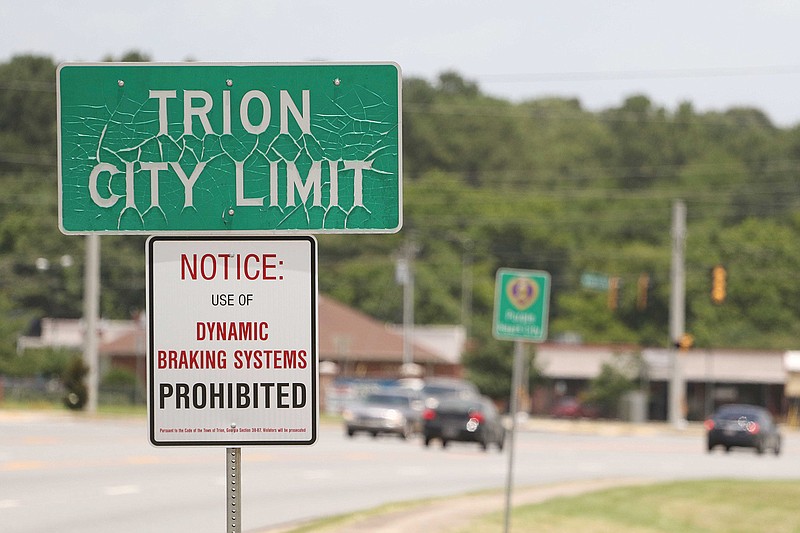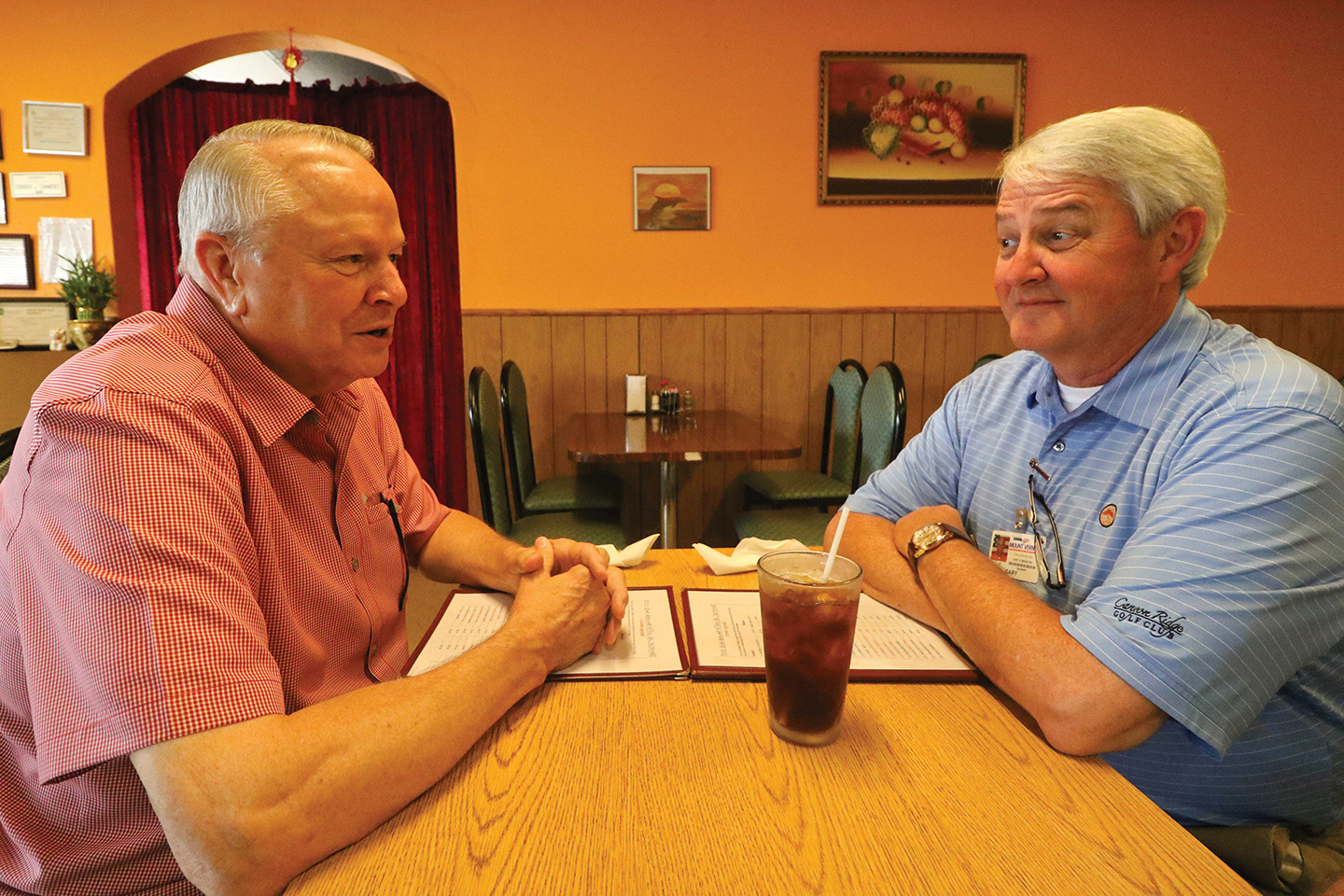The town of Trion, Georgia, lies almost 50 miles south of Chattanooga, down U.S. Highway 27, through Rock Spring and Lafayette and just short of Summerville.
Trion is in Chattooga County, a 313-square-mile area that is framed on the west by the Alabama-Georgia state line, and on its east by one of the last southern outcrops of the Appalachian Mountains. Chatooga County is home to about 26,000 residents and about 10,000 workers, according to the United States Census Bureau. In early summer, according to the Bureau of Labor Statistics, about 6.2 percent of those workers were unemployed.
More Info
LEAN ON MECities that rely heavily on one corporate citizen*Collegedale, Tenn. — McKee Foods operates a factory with 2,750 employees*Dayton, Tenn. — Michigan-based La-Z-Boy operates a factory with 1,300 employees*South Pittsburg, Tenn. — Lodge Manufacturing Co. operates a factory with 270 employees*Flintstone, Ga. — Yates Bleachery operates a factory with 120 employees*Cleveland, Tenn. — Roper Corp. operates a factory with 1,650 employeesSource: Chattanooga Area Chamber of Commerce, La-Z-Boy Inc.
Embedded in Chattooga County is Trion, a tiny town of 1,700 situated in the northern part of the county, just off Highway 27. While the total number of Trion workers isn't recorded by the Census Bureau, the town's unemployment rate (6.5 percent) is. That's nearly on par with Georgia's average state unemployment rate, which in late spring hovered around 6. 3 percent.
Trion also boasts deep pockets, and a $15 million town budget. And you could totally miss it, if you're not careful. Trion isn't a major industrial center, or arguably even within the orbit of one. Trion's town hall building lies almost two miles off U.S. 27, the major thoroughfare through the area.
But the town has, in its mind, the thing it needs most. Trion has Mount Vernon Mill No. 3, the largest denim manufacturer in America. Or, depending on how you look at it, Mount Vernon Mill has Trion.
###
Larry Stansell is Trion's part-time mayor who puts in a full-time workload. His is a native of the tiny town, a University of Georgia grad and a retired furniture store owner. Stansell was elected mayor of Trion in 2013, and that was also the year he closed his family's furniture store business.
The mayor never worked at Mount Vernon Mill himself, though his parents had stints of employment there, and it's nearly impossible to find anyone in Trion (or the greater-Chattooga County area) who doesn't have some sort of the tie to the company.
The mill pays about 85 percent of the taxes in Trion. It employs about 1,400 people. "They are the wealth of our area," Stancil says.
In Trion, there is a central, sprawling public school complex equipped with athletic facilities comparable to some small colleges. The K-t0-12 school system is so large, and Trion so small, that about 80 percent of its students come from outside the city limits. Out-of-town students pay $150 a year to go to the city's schools.
Stansell brags on the city school system, which has generous funding for a local system of its size, thanks in large part to Mount Vernon, he says. According to the George W. Bush Institute, an education reporting organization, Trion's city school students in 2004 to 2007 performed better than about 80 percent of students elsewhere in Georgia at math and reading. And in 2009, students in Trion's schools performed better than 76 and 79 percent of students elsewhere in the country at math and reading, respectively.
Up until the early 1990s, Trion's schools were still located in the heart of town, in the shadow of Mount Vernon Mill. The school was built decades prior with Mount Vernon money so that the children of employees and managers would receive a top-notch education, according to Stansell. The mill's top officials paid to have college educator-level teachers brought in for the schools, no expense was spared.
But in the early part of 1990, disaster struck.
In mid-February of that year, heavy rain caused the Chattooga River to reach flood level, breaching its banks and running wild through the heart of town. Trion Elementary School, nearby, was struck: five feet of river water, mud and trash coursed through the school's hallways, according to Times Free Press archives. For the remainder of the spring semester, the school system made do and carried on with borrowed textbooks and piece-meal clean-ups, which went on all summer.
Trion needed help.
Mount Vernon leaders responded with the question: How much?
Gary Branton, vice president of denim manufacturing at Mount Vernon, says the mill gave Trion $2 million ($3.65 million in 2015 money) to build its new school and replace its devastated one. Trion shortly thereafter moved its school system away from the river and onto a picturesque hill with a view above town.
"Thanks to the seeds that were planted by Mount Vernon, (we) still have one of the top 2,000 schools in the nation," says Stansell. "We graduated 96-plus percent last year. A couple of years ago, we graduated 100 percent, which is unheard of today."
"This is a Mount Vernon town," he says. "Has been forever."
###
Here's what you have to understand about the relationship between Trion and Mount Vernon Mill No. 3, say leaders of the small town and its pride mill. The identities of the two are intertwined. Interdependent in many ways, they are forever linked and part of one another, no matter what happens in the future.
The mill opened here in 1845. The town wasn't incorporated for another 95 years. The plant narrowly avoided disaster during the Civil War (or, the War of Northern Aggression, as it is sometimes called in these parts), when in 1864, William T. Sherman, supreme commander of the Union's western armies, began his march through the South's heartland.
After breaking through Chattanooga and Chickamauga, Sherman passed through present-day Trion, and by its cotton mill, where reams of gray uniforms worn by soldiers of the Confederate States of America were manufactured. But Sherman didn't burn the mill. And rumors still swirl about why.
"The plant was spared the normal burning procedure he used in the South," says Branton.
One version - the one Mount Vernon officials tell - is one of the three founders of the cotton mill was a Northern transplant, and a Union sympathizer. And he put his Northern upbringing and sympathy for Sherman's cause on the table, over a private dinner with the Union commander. Then, without much ado, Sherman left town. And instructed his men to leave the mill alone.
Ironically, says Branton, the mill burned anyway 10 years later, and had to be rebuilt.
###
The town of Trion was incorporated in the 1940s, almost 100 years after its cotton mill was founded.
The name given to the four-square-mile town is a hearkening to the three founders of northwest Georgia's first cotton mill: Andrew P. Allgood, Spencer S. Marsh and Col. W.K. Briers. The town named itself "Trio" with an "n" added on.
There would be no town without the mill, says Stansell. The mill had built all the houses in town at one time. Its owners built and funded the school, built and funded a hospital, a theater and a full-size indoor, Olympic-size swimming pool (that has since closed). The famous tavern building, now a restaurant, was once a must-see for Highway 27 motorists. It was built by one of the mill's previous owners to host a national cattle show.
Trion's utility infrastructure is almost entirely put to industrial use, because of Mount Vernon. But, as with so many things here, there's a trade-off for residents of Trion: cheap water and sewer services.
Branton also says that Mount Vernon Mill is sitting on a huge reservoir of water, a monumental resource for a plant of its size. It's one of the things - among many - that keeps Mount Vernon in Trion.
Officials of Trion and Mount Vernon sing praises for one another, almost to the point of doting. An ideal corporate citizen, say town officials of the plant. The town's mill. The town's heritage. The town's employer.
Trion is a perfect place to call home, say mill leaders. A ready-and-willing workforce. A government that gets the needs of industry. But the great "ifs" do hang out there.
Of course we consider what would happen if the relationship collapsed, says Branton.
Of course, says Stansell.
Beneath the genuine layer of brother love between the mill and the town, there is an equally-genuine layer of trust - and vulnerability. Both entities know they are sticks propped against one another. The town gets millions in taxes and a huge employer. And the mill gets cheap natural resources and a deep pool of recruits.
If you would have asked him a decade ago, Branton says he doesn't know that he could have promised the mill would always be here. And a weaker mayor, says Stansell, might even today be intimidated by the town's relationship with its first citizen, Mount Vernon Mill No. 3.
Instead, Stansell and Branton sit sometimes over lunch at Trion's most-popular Chinese restaurant, and they speak candidly about things. About the perks, and the what-ifs.
About Trion, a true, died-in-the-denim company town.

